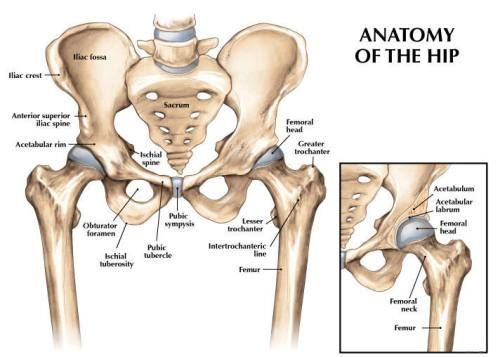Written By: Dr. Kevin Vieser, DC, CCSP, ATC
Chiropractic Physician & Athletic Trainer
Those of us who exercise regularly might be familiar with hearing of the squat being referred to as the “king of all exercises”, a prestigious name earned for multiple reasons: it works your body from head to toe, it allows you to lift heavier than most other exercises, it carries over to daily life, and is a great tool for building overall strength. HOWEVER, just because it is a great exercise, does not mean it is the right exercise for you (…yet). If you are not a gym goer, this is information still applies to you, trust me.
While there are several ways to build the mobility and stability to safely get into a PROPER squat position, there is a milestone that (I feel) is often forgotten or neglected before loading into a squat: the ability to maintain single leg balance. In the picture, you will see the beautifully featured pelvic and hip bones. The upside-down triangular bone with the 8 holes in the middle (the sacrum) is where the load of our bodies is transferred into the pelvis, and then into each leg.

In a perfect world, that load is distributed evenly, and one side is no more difficult to stand on compared to the other. More often than not, one side of our body is stronger and better able to control our body weight. When standing in line at Trader Joe’s (**I’m open to sponsorship opportunities**) prime time on a Sunday at 3 pm, you might notice your weight shift onto one leg, to conserve energy, and sometimes to a fault to the point where primal movements that we had at a very young age become dysfunctional.
Whether you’re squatting to pick up a child, to move a piece of furniture, or to lift a loaded barbell in the gym, try this quick assessment!
Grab a friend, a wall, or something for support nearby, and try holding a one-leg stance on each side for 20 seconds
*Hint – Performing in front of a mirror or filming the stance will work best*
Take note of a couple things:
– Is one leg easier to stand on than the other?
– Does the pelvis drop on the side of the leg that is non-weight-bearing?
– Is there pain?
If your answer is yes to any of those things, there is dysfunction. Your deficiencies need to be addressed sooner rather than later.
The complicated part is that it takes an expert set of hands to know if the SOURCE/CAUSE of the problem is coming from the hip, the knee, the ankle, or the foot. Additionally, there is no book that says ‘two things cannot be the cause of the same dysfunction’. That is why our team of multi-disciplinary clinicians at Comprehensive Medical Care and Fassst SPORT take the time to fully assess and diagnose our patients.
There are multiple treatments to help with this dysfunction and better prepare you for the gym, for playing with your child, or the common household chores. It is best to treat this before continuing to load an UNSTABLE BASE where you are setting yourself up for significant injury. It’s often the movements when we are not bracing ourselves (something as silly as picking up a pencil) that put us through a world of pain and requires medical intervention. Our goal is to help you avoid that.
I’ll leave you all with this: If you can’t easily stand on each leg in a single-leg stance, OR notice one side is even slightly less stable than the other, you need to invest in your body and get those faulty patterns assessed and addressed… that especially goes for you if you plan on loading large amounts of weight to your squat in the gym.


